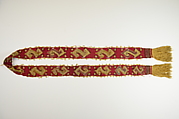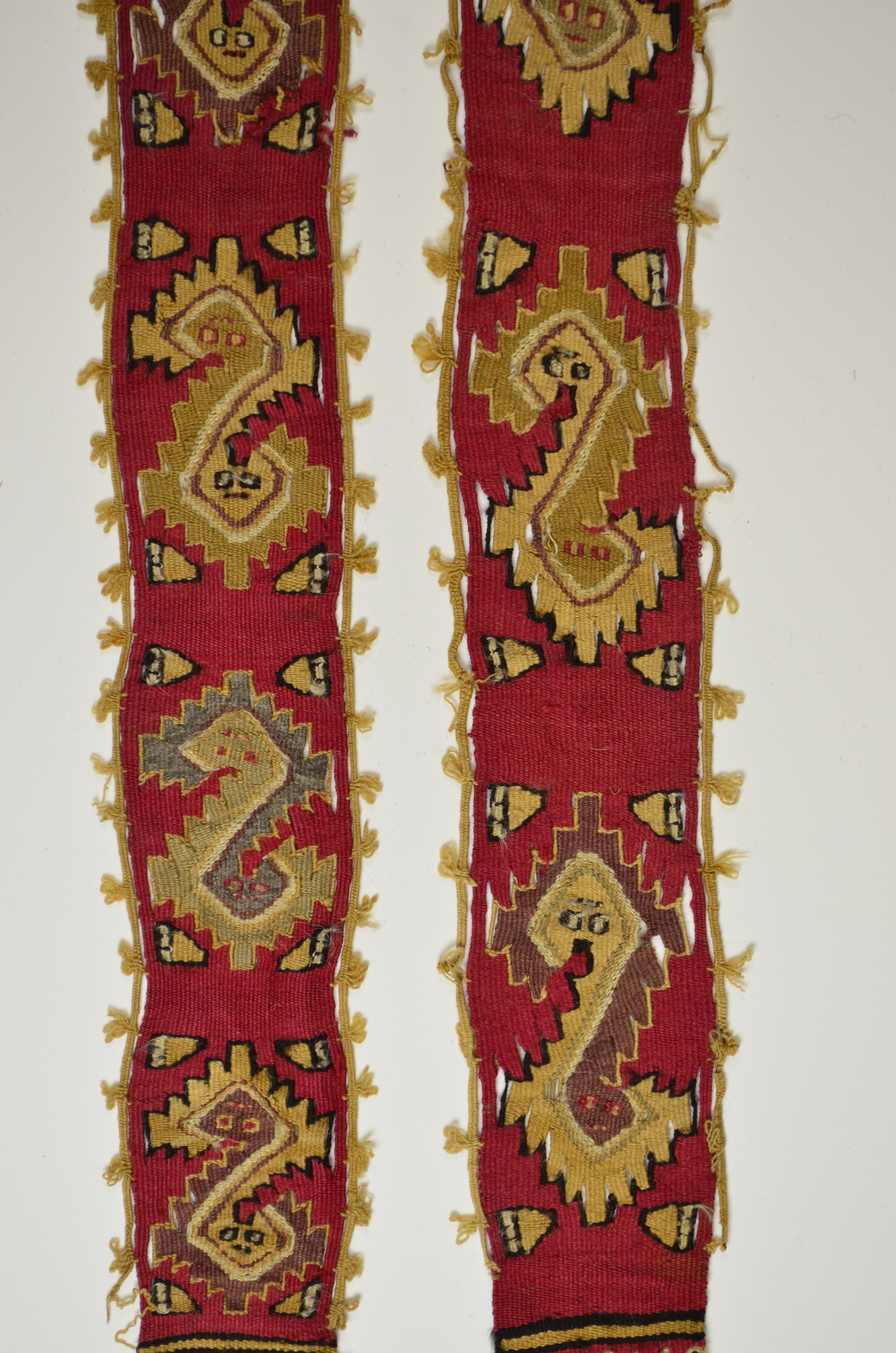Sash
Not on view
This long, thin strip of textile was woven using dyed camelid fibers along with undyed cotton yarns. The textile features interlocked geometric figures of alternating colors with simple faces and accompanying trapezoidal forms running down its length, creating a repeating composition on a dark red background. The terminating width of the object has a small geometric border just before meeting the elongated yellow fringe. The length of the object is framed on either side by a thin yellow band with small bunches of fringe at regular intervals. The motifs shown in this work evoke earlier traditions of the north and central coasts of Peru including those of the Paracas and Moche cultures (see, for example, MMA 1987.394.706 and 33.149.28). Chimú weavers built upon these foundations, but with further elaborations to produce their own distinctive style.
One aspect of these elaborations is the use of contrasting colors in the bodies of the s-shaped figures. At the same time, it has been suggested that one way Andean groups depicted the movement of figures around each other within a design was by utilizing snake heads, or other motifs such as corn cobs, to denote where one element is passing over or under another (Frame, 1984). Following this perspective, the intertwined stepped s-shaped motifs represent a constant flow of natural oppositional forces in the Andean world. The stepped appearance of these figures recalls geometric depictions of catfish found in earlier cultures, with facial features evoking depictions of fish found in Chimú sculpture. These s-shaped figures speak to ideas of aquatic life that would have been vital to existence on the Peruvian coast. The triangular shapes occupying the spaces around the intertwined aquatic motifs, for example, may represent a pelican’s foot. Pelican imagery was a favored subject in Chimú art, perhaps due to the creature’s noteworthy predatory skill. The placement of the pelican motif encircling the aquatic entwined figures could imply an underlying predatory theme. In this case, the weaver has chosen to use familiar Chimú depictions of oceanic life forms to convey this message.
The band, a long strip of tapestry-woven textile, is weft-faced, with attached smaller strips of weft-faced cloth. Weft-faced textiles feature horizontal yarns that are tightly packed together so only the horizontal strands are visible on the face of the fabric. Camelid fiber was preferred for dyed yarns because of its superior ability to absorb and hold color; cotton, which was available in many natural hues, was used to achieve a subtler palette. This work was constructed utilizing a traditional backstrap loom, a weaving device used in the Andean region for at least 6,000 years by the time this band was created. This type of looming system utilizes wooden sticks of various widths and lengths with one end of the loom tethered to a post and another strapped around the back of the weaver. This constant tension allows for the manipulation of yarns to produce high quality cloth.
The Chimú were one of the most expansive cultural groups operating on the north coast of Peru for the 500 years preceding Spanish arrival and subsequent colonization. The Chimú constructed the largest city in the Indigenous Americas, the coastal capital of Chan Chan, renowned for its craft production. This also made the city a hub for transregional trade between contemporary cultural groups throughout the Andes and beyond. Fine textiles were one of the most sought-after products in the Chimú interaction sphere. This band was made for a high-status individual during the time of the Late Chimú/Inca Occupational period in what Ann Rowe has called the Plain Crescent Headdress style of Chimú weaving (Rowe, 1984).
This corresponds to the timeframe when the Chimú were experiencing a slow political stagnation, weakening them and making them vulnerable to the Inca, who were able to conquer them c. 1470 and occupy their coastal territories. The Plain Crescent Headdress style is named for the figures wearing headdresses with little to no decoration—the vast majority of Chimú textiles from this period were made in this style (see MMA 1979.206.590 and 28.171.8). This textile band, despite the absence of this motif, can be correlated to this period on technical grounds.
This finely woven band was certainly crafted for an elite individual, but it is not clear how the band functioned as part of a garment ensemble. Long textile bands such as this one were common staples of Andean dress. These bands could have served a variety of purposes. The present example was likely woven as a belt that would have been wrapped around the large, oversized, tunic. The fringe present on the terminating edges of the textile differs from the constructions typically associated with turbans, which feature bifurcated terminating edges with attached segmented and elongated tassels (see MMA 19.143). However, it is important to remember that this textile could have served both functions. For example, it is possible that when it was first created this textile was intended to be a belt for a tunic but was later used to secure a turban. Nonetheless, this textile band would have encoded the cultural expressions of the weaver and the memories of the people, or person, who wore the band during their lives.
Maximillion A. Alegria
Adrienne Arsht Intern Art of the Ancient Americas, 2023
Published:
Frame, Mary. “The Visual Images of Fabric Structures in Ancient Peruvian Art,” in The Junius B. Bird Conference on Andean Textiles, edited by Ann Pollard Rowe. Washington D.C.: The Textile Museum, 1986, pp. 47-80, fig. 6.
References and Further Reading:
Rowe, Ann Pollard. Costumes and Featherwork of the Lords of Chimor. Washington DC: The Textile Museum, 1984.
Scher, Sarahh, and Billie Follensbee. Dressing the Part. Gainesville: University of Florida Press, 2017, pp.1-13.
Quilter, Jeffrey. The Ancient Central Andes. New York City: Routledge, 2014.
Verde Casanova, Ana, Cecilia Bákula, Carmen Arellano Hoffmann, Ann Peters, María Jesús Jiménez, and Mary Frame. Mantos para la eternidad: Textiles Paracas del antiguo Perú. Madrid: Ministerio de Cultura, 2010.
Makowski, Krzysztof, Alfredo Rosenzweig, and María Jesús Jiménez. Weaving for the Afterlife: Peruvian Textiles from the Maiman Collection, Vol I. Israel: Kal Press Ltd., 2006.
D’Harcourt, Raoul. Textiles of Ancient Peru and Their Techniques. Seattle: University of Washington Press, 1962.
Topic, John. “Craft Production in the Kingdom of Chimor,” in The Northern Dynasties: Kingship and Statecraft in Chimor, edited by Michael E. Moseley and Alana Cordy-Collins. Washington DC: Dumbarton Oaks, 1990, pp.145-176.
Due to rights restrictions, this image cannot be enlarged, viewed at full screen, or downloaded.
This artwork is meant to be viewed from right to left. Scroll left to view more.



